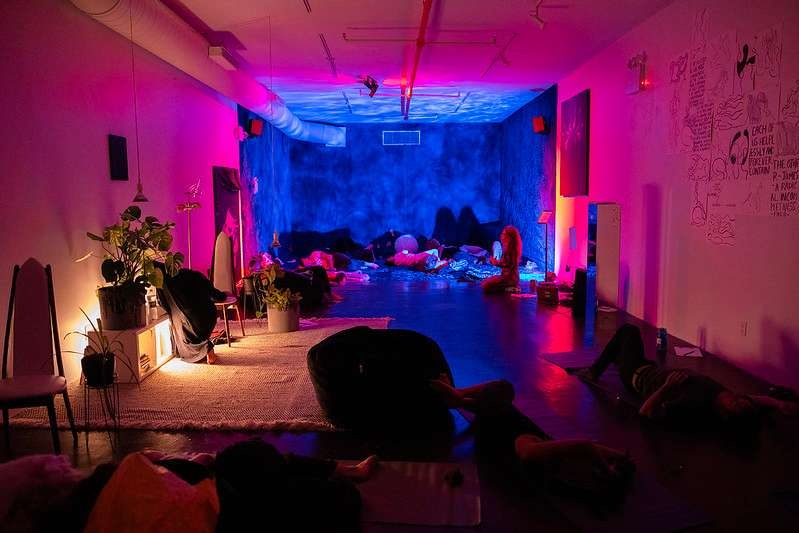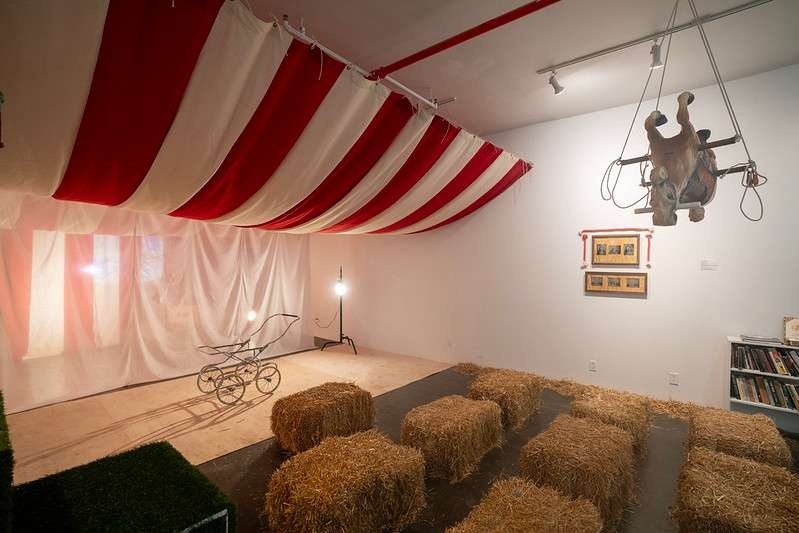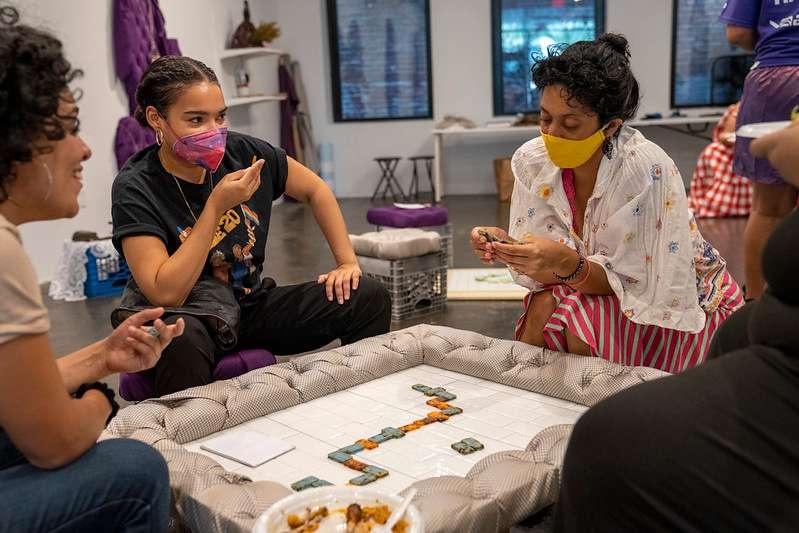

Words are things. The late Maya Angelou once said this as part of a larger lesson she believed was important to understand one’s mindfulness in the use of language. It is clear in Francheska Alcántara’s Secure the Bag, Mint the Soaps and Throw the Bones that they too understood Angelou’s lesson. Alcántara’s choice of title offers an overview of what a person can or will experience in this exhibit, a reimagining of everyday objects such as brown paper bags, soap, and dominoes that dives deeper into questions of culture and identity.
At the entrance of the exhibit, a visitor encounters an arrangement of what, at first glance, seems like the iconic Hispano soap bars, recognizable to many Dominicans. Upon closer inspection, it is clear that some of the packages of soap resting on top of a double stack of plastic milk crates are unlike the others: the familiar “Hispano” label has been recreated to read “Afro, Black, Negre.” A series of large, purple tufted wall pieces in amorphous shapes lean against the right and left walls. Draped across each piece are chains of varying lengths that end with a type of pendant made of a manipulated brown paper bag. Some are dyed, some crushed, encrusted with crystals of sugar, salt, adobo, soil, coffee grinds, and coconut oil, transforming them into jewels. The wall pieces overlook three tables set atop plastic milk crates at the center of the space. The tables are surrounded by plastic milk crate “chairs” with tufted cushions. Alcántara has crafted dominoes out of pieces of colorful, slippery, fragrant, and handmade glycerin soaps, replacing the traditional “bones” one might typically expect to play with (or slam).
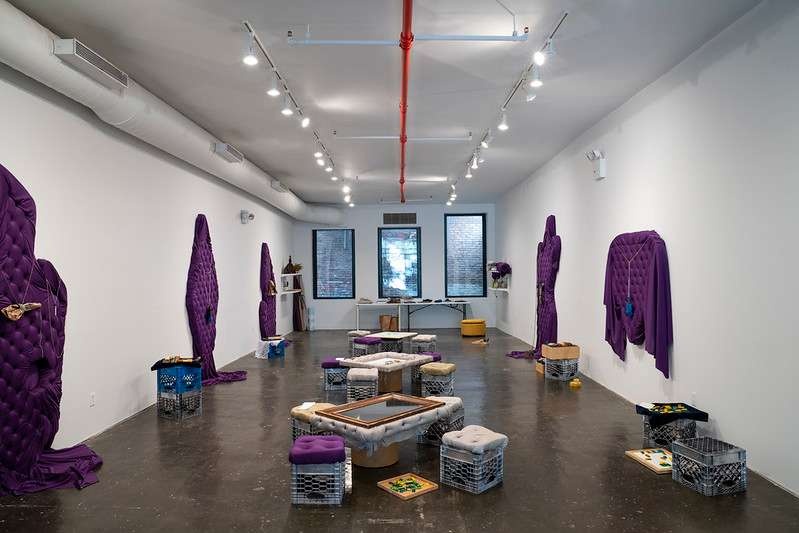

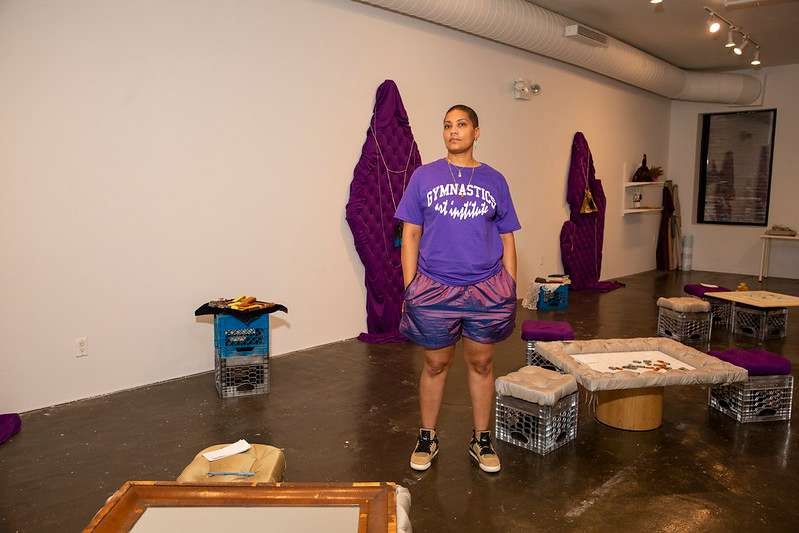

Collectively, the elements create a room to engage in conversation and think deeper about objects that often are seen so regularly that they aren’t given much thought beyond their utility. Alcántara describes how these objects “are [a] staple in every household,” and they have a complex role in Dominican society (and across the island of Ayiti). By name, Hispano soap signals the ever-present colonial history of the Spanish, who established their first colony on the island in the late 15th Century. Alcántara understands that this, “has always been a[n] unresolved history, a history that needs to be rectified…and [that] informs so much of the challenges that we have as a people. The history that Hispano soap relates is the racialization of the Dominican Republic, which has historically moved hand-in-hand with notions of cleanliness and purity.” Alcántara’s intentional use of soap in this exhibition points to this historical relationship between nations that also questions who and what gets to be considered clean or pure within them. Within the Spanish colonial empire and in the ongoing history of the Dominican Republic, ideas of cleanliness and purity reflect white supremacist values and preferences that skew towards anything that is white or linked to whiteness. The belief that the cleanest bodies are white bodies has been intentionally constructed and enforced in the country.
What happens then when this soap, which takes its name from those Spanish colonizers, is commonly used in a society that is majority Black and/or of African descent? Moreover, Hispano soap, also commonly referred to as jabón de cuaba, has a main ingredient that is native to the island: cuaba, which comes from a species of pine tree that historically has been used for lighting fires and cultivating resin for products. That is to say, this famous soap is the convergence of indigenous ingredients controlled by colonial rule and implemented on mostly Black bodies. Rinse and repeat.
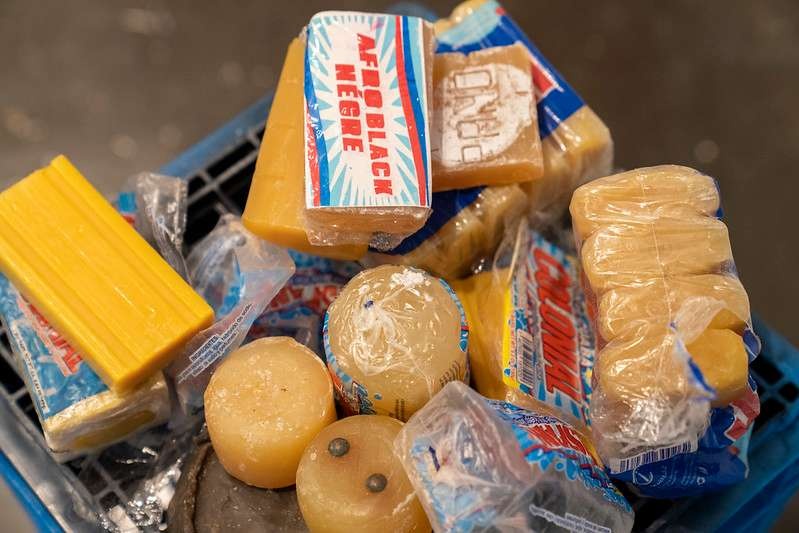





Hispano is more than just soap in everyday Dominican life though, it’s a cultural icon that brings joyful memories to people, a nostalgia that Alcántara recalls as well: “[It] just felt so good, you know? It felt like super clean.” Alcántara also recalls seeing all kinds of uses for it, from patching holes in a leaky pipe to washing clothes. The many uses of this one product speaks to issues of class and of the need to creatively use a product because money is scarce or unstable. In a conversation, Alcántara shared about the common practice of people buying pieces of the soap at a colmado (a type of neighborhood convenience store) when money was tight yet the need to clean or be cleaned cannot be put off.
Alcántara’s exhibition echoes a setting found all across the Dominican Republic, the Caribbean, and throughout the African Diaspora of people coming together to have fun despite their circumstances. This space also provided for conversations that explored the players’ own lived experiences and understandings of the questions and ideas brought up in the exhibit, the colorism that persists in other colonized lands. For Alcántara, the domino games “felt very communal and multi-sensory as people saw each other, listened, touched the soap, smelled it, and broke bread. So it felt safe and immersive.“
In alignment with the thread of reinterpretations throughout the exhibit, there is a freshness to Alcántara’s art here, which is noticeable in the evident queerness of the work—and is perhaps most present in the tufted pieces. Like the queer experiences so many identify with, the wall pieces—made sensuous by the deep, purple, velvet bedsheet-like fabric that is imperfectly shaped—can not be defined by one thing only. The work is complex like the queer experience, like the diasporic experience, like the experience of living in this world that demands more of us than we are often willing to give. This discussion of bodies also connects with the “secure the bag” element of the show’s title that Alcántara relates to, “our most important asset [which] is our brown and Black bodies. These bodies ascend to a higher level of consciousness once we understand that they are queer bodies and are held by these purple higher/femme entities.”
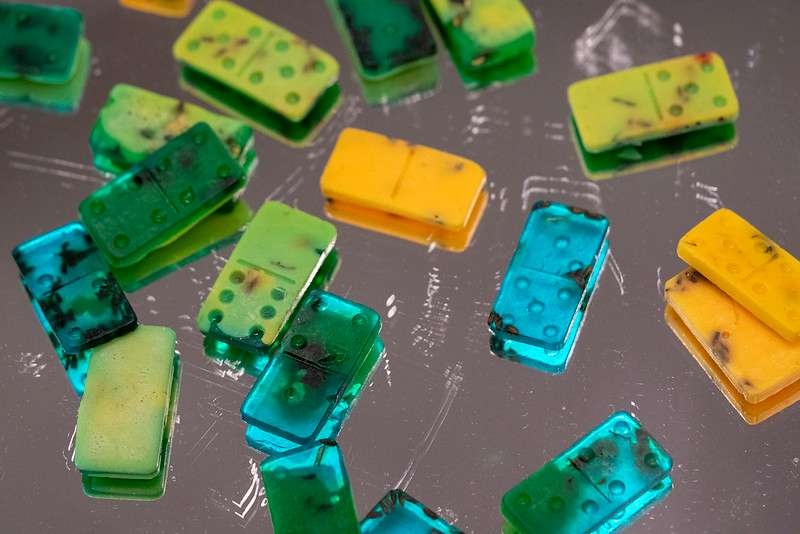

Alcántara’s show offered a bridge into more closely and critically looking at objects people have seen countless times over the course of their lives, but may have not given much thought to. Their decision to place the tufted pieces on either side of the room created a type of figurative perimeter and container of queerness for the show that felt good and appropriate in the effort to disrupt these mundane objects. Seeing the words “negre,” “afro,” and “black” carved into these bars of soap opened up the minds of presumably Black and brown visitors who experienced the exhibit to consider and question how closely we pay attention to the details of the products we consume. It may be safe to assume that on an everyday basis people aren’t wondering what the impact of seeing a word like “Hispano” on a bar of soap so regularly does to them as a Black person, or how it is sending a very clear yet subtle message about who they get to be in their society built on colonial rule and persecution of anything Black. Alcántara signals as much in their inclusion of brown paper bags, which push against colorist measures of the “one-drop rule” that has historically governed determinations of acceptable blackness in the US as well as the crux of latinidad that is always about one’s proximity to whiteness.
What remains after a game of dominoes, or a bath with Hispano soap, or the use of a brown paper bag? Memories, residue and left over material. Secure the Bag, Mint the Soaps and Throw the Bones is an offering for what to do with those experiences, their remainders and the opportunities to reimagine them altogether to empower the people whose daily lives they are a part of.
About the artist
Kleaver Cruz
Writer
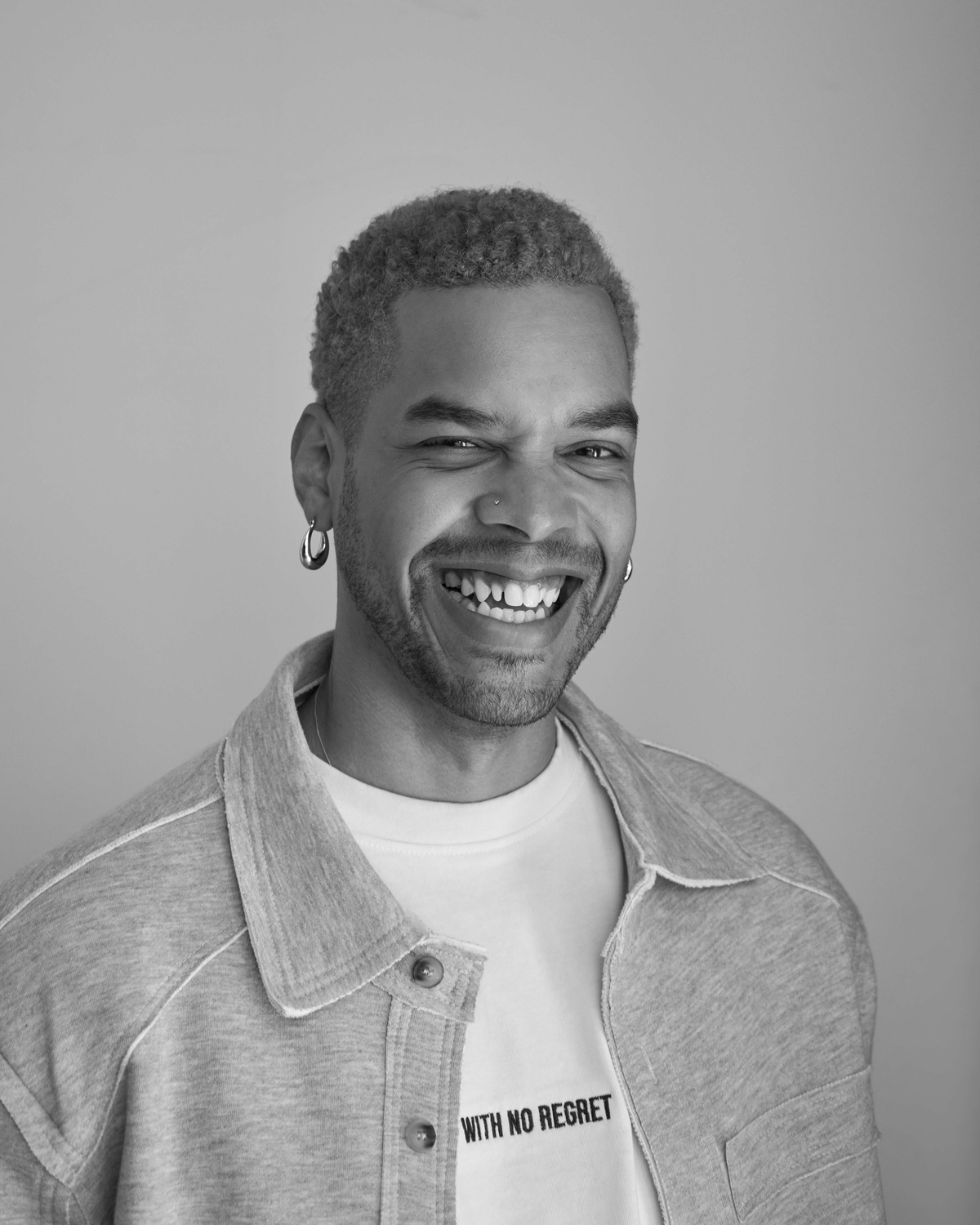

A lover of words and their meanings across languages, Kleaver Cruz (they/them) was born and raised in Uptown, NYC between The Bronx and Washington Heights with their twin brother and small Dominican family. Kleaver is a Black queer writer and educator who has presented and conducted work across the African Diaspora and continent in places like Brazil, South Africa and The Netherlands, among other countries. Kleaver is the Facilitator of The Black Joy Project, a digital and real-world affirmation that Black joy is resistance. They believe in the power of words to write the stories that did not exist when they needed them the most.
They are the author of The Black Joy Project: A Literary and Visual Love Letter to How We Thrive. (Mariner Books/Harper Collins).
Explore/Archive
See allDecember 2025
The INSTITUTE FOR TRANSHUMANIST CEPHALOPOD EVOLUTION and Learning from Octopuses
Barbara London
Barbara London reflect's of Miriam SImun's INSTITUTE FOR TRANSHUMANIST CEPHALOPOD EVOLUTION
October 2025
streamlined reflections, courtesy of noise canceling headphones
Gabrielle Rucker
Gabrielle Rucker reflects on the radical intimacy and auditory life at the heart of Deli Radio
July 2025
Tell My Jockey: CUNTRY’s Discourse From the Horse’s Mouth
Ericka Pérez
Assembly fellow Ericka Pérez reflects on clowning, resistance, and CUNTRY’s radical refusal to perform.
